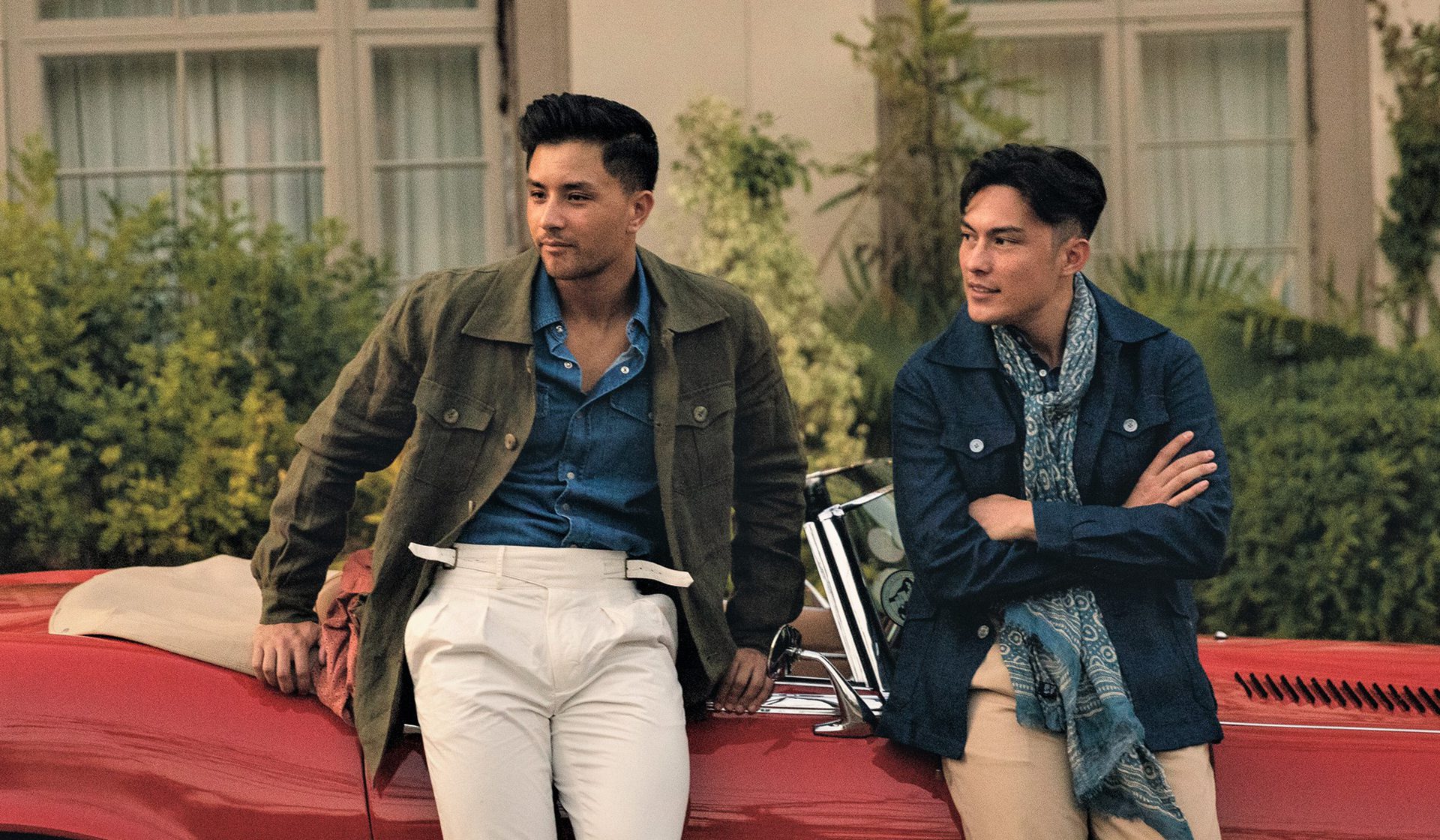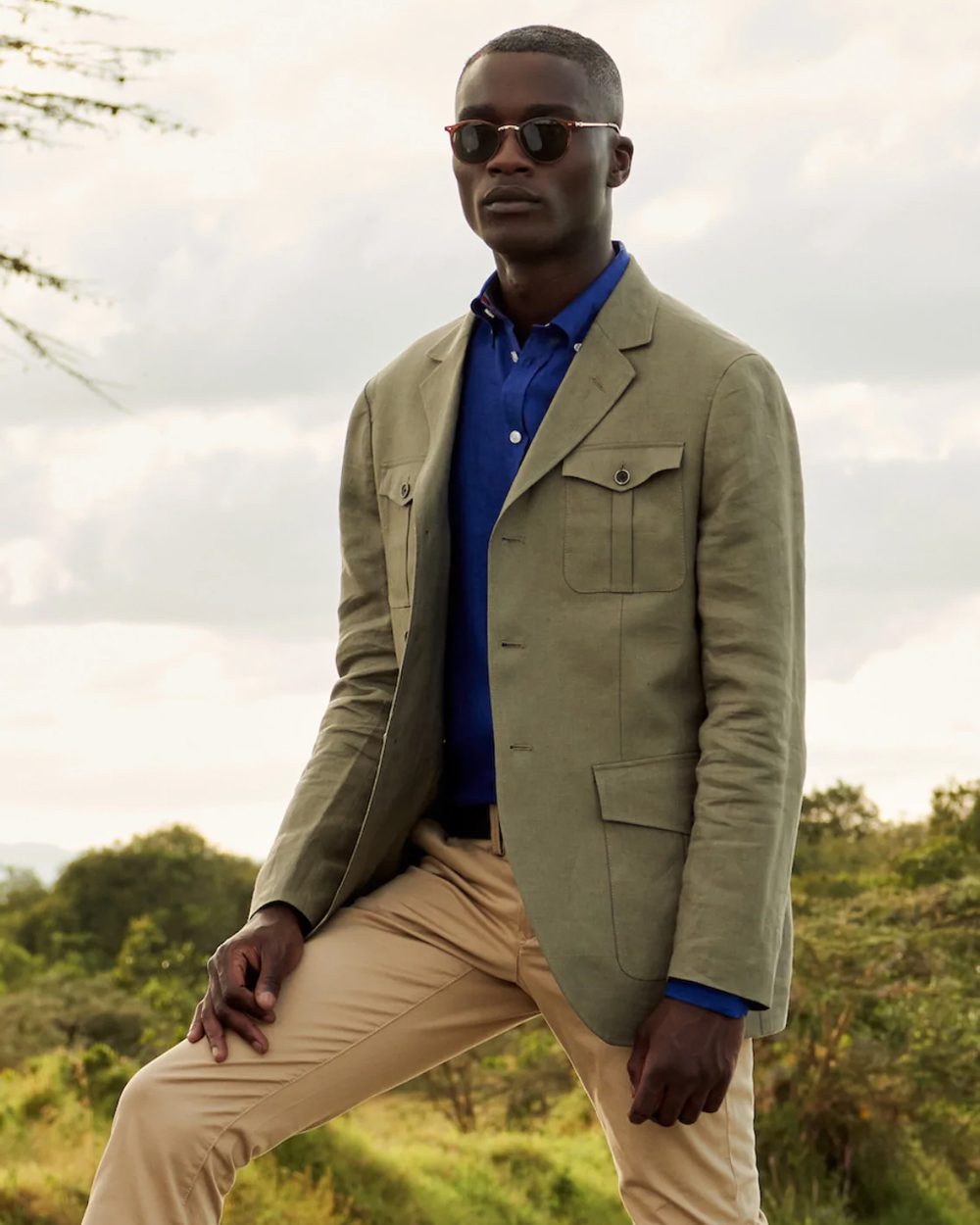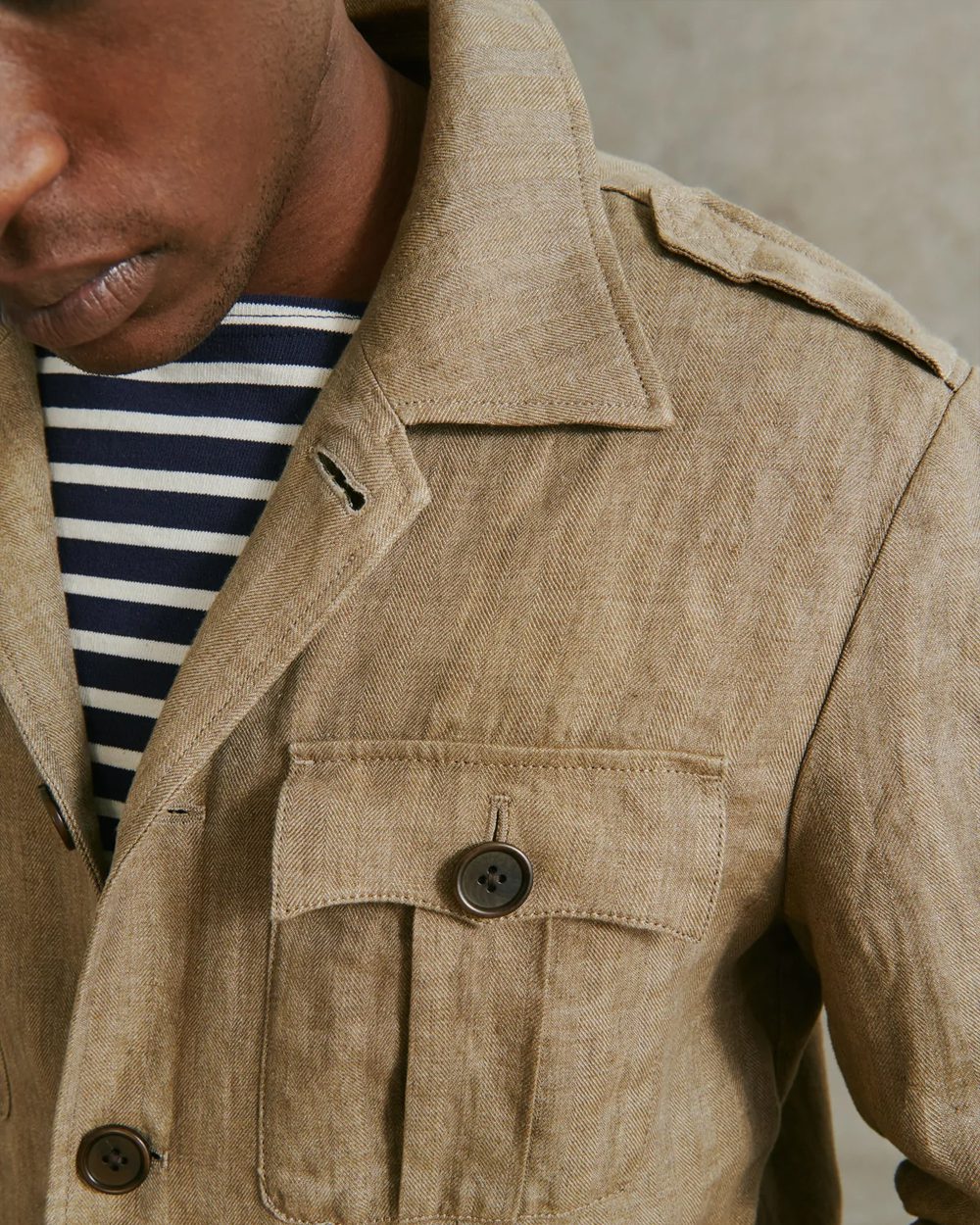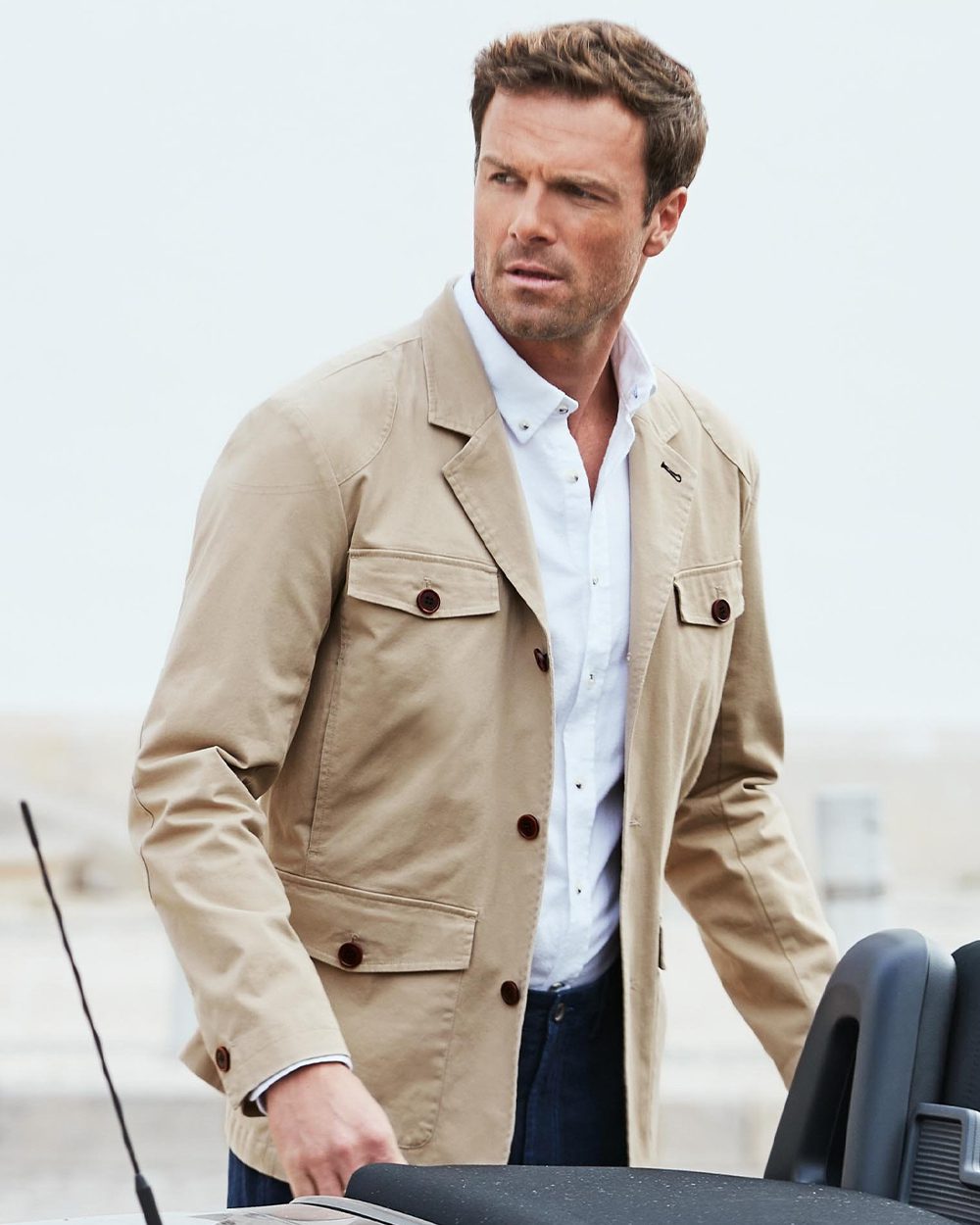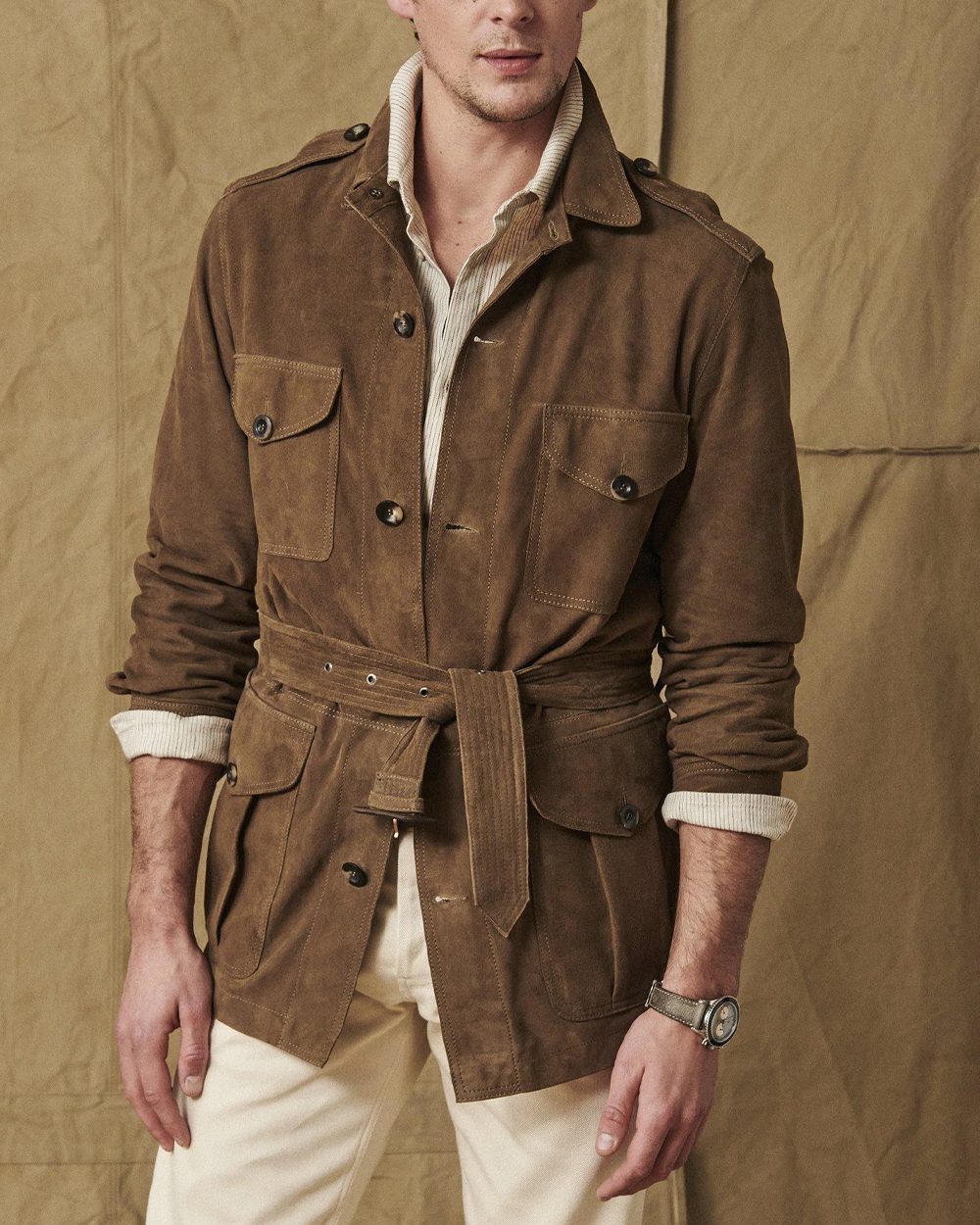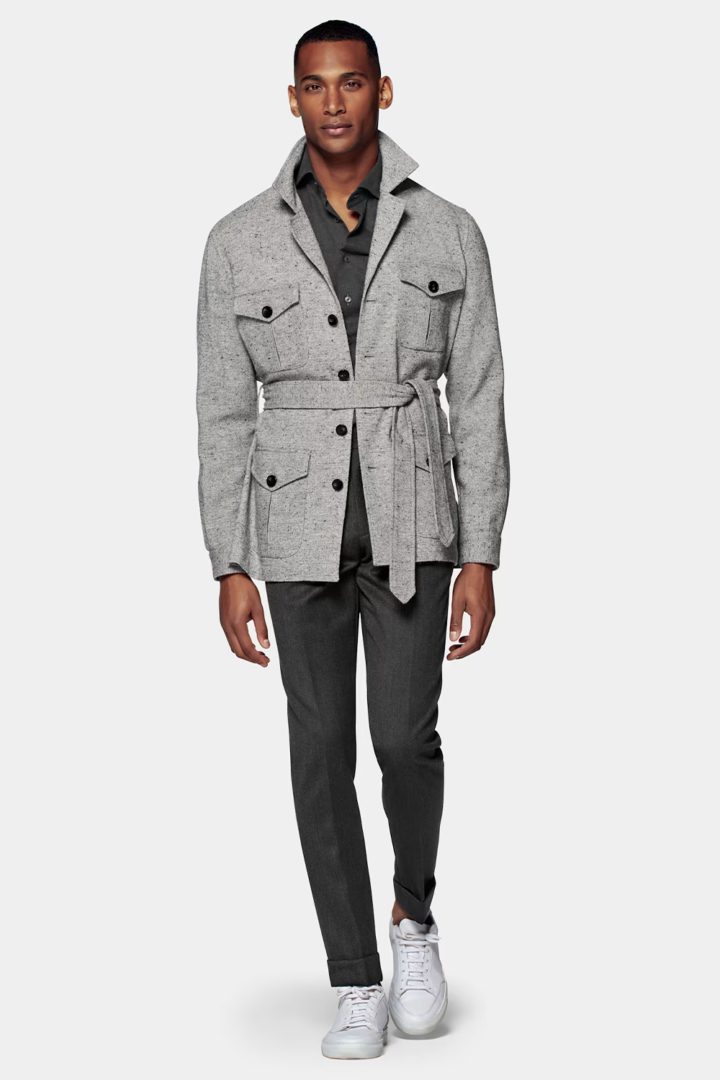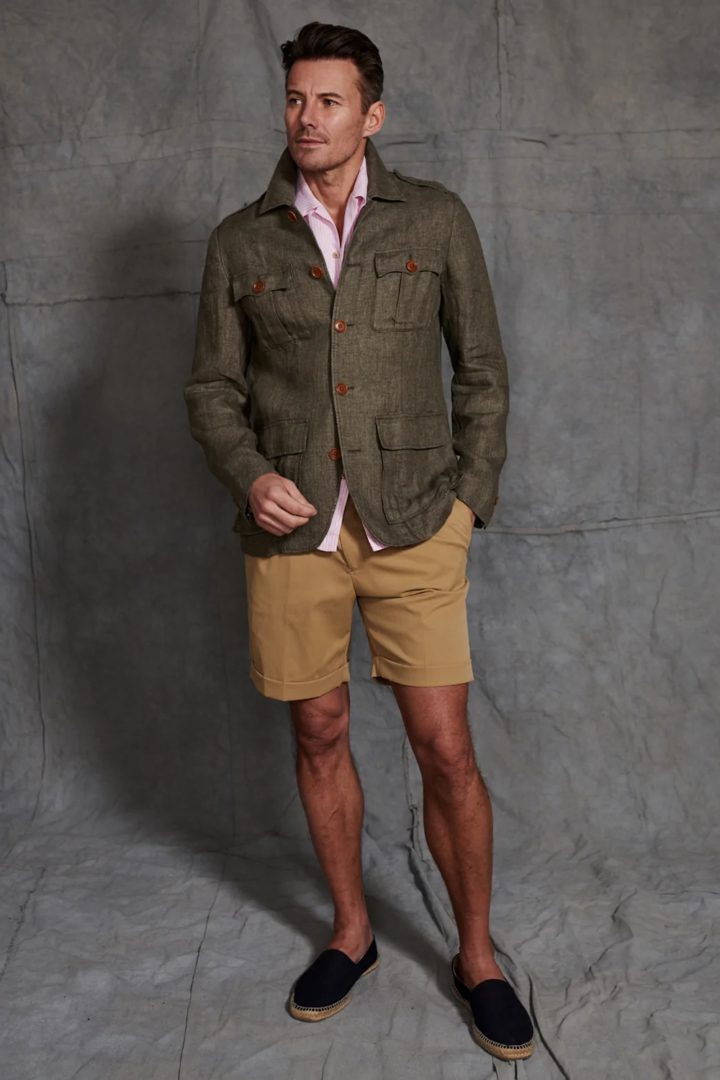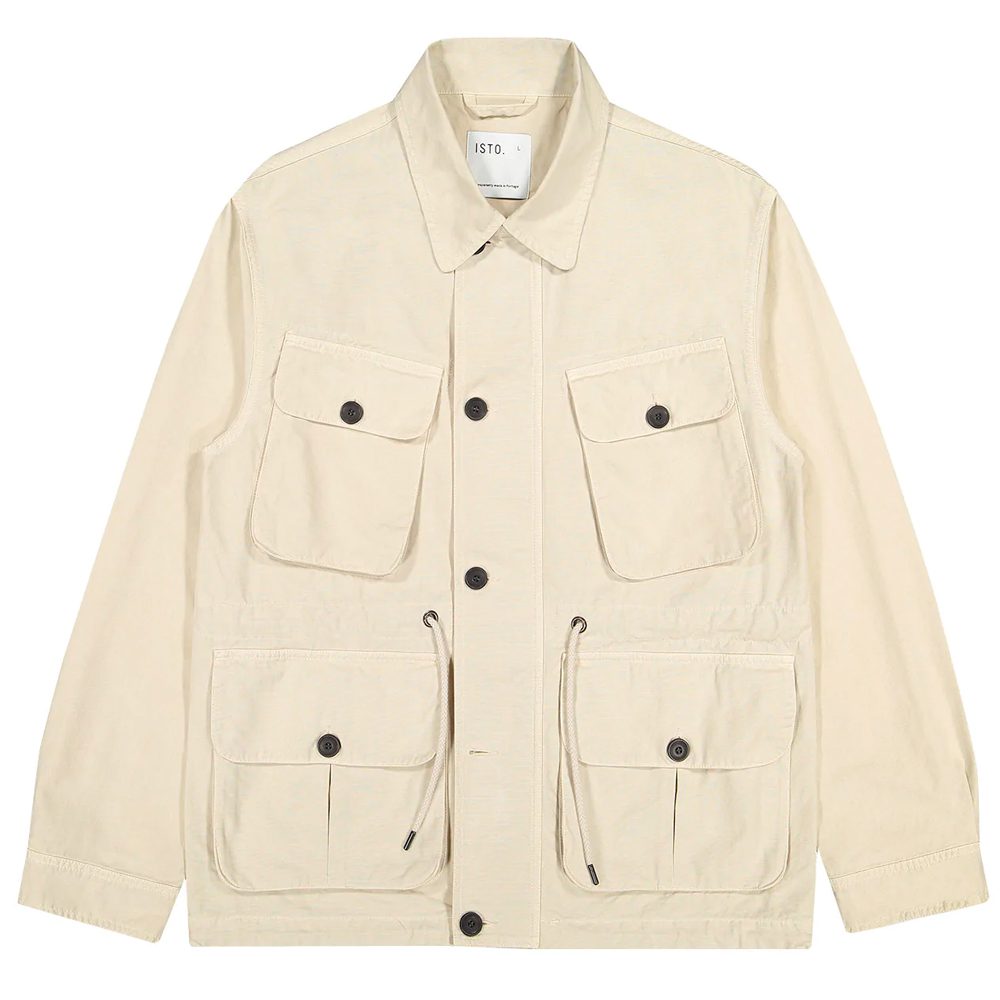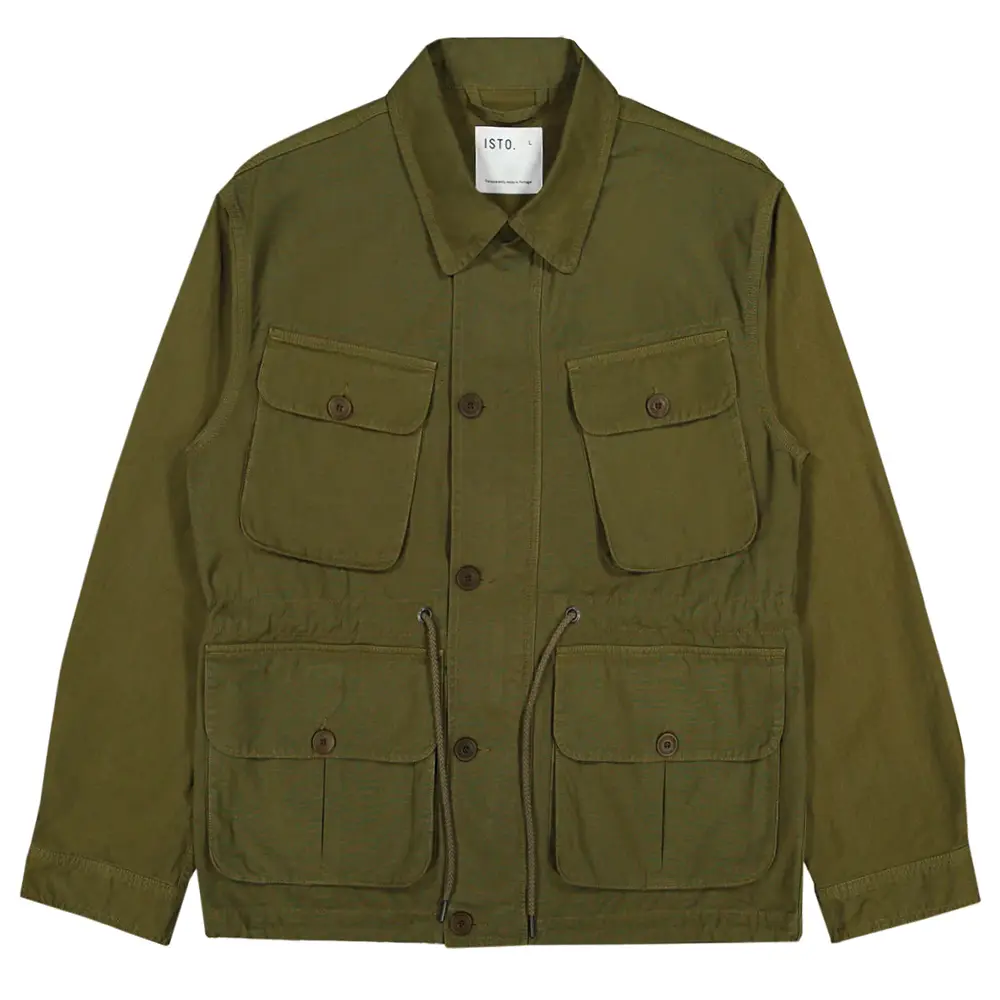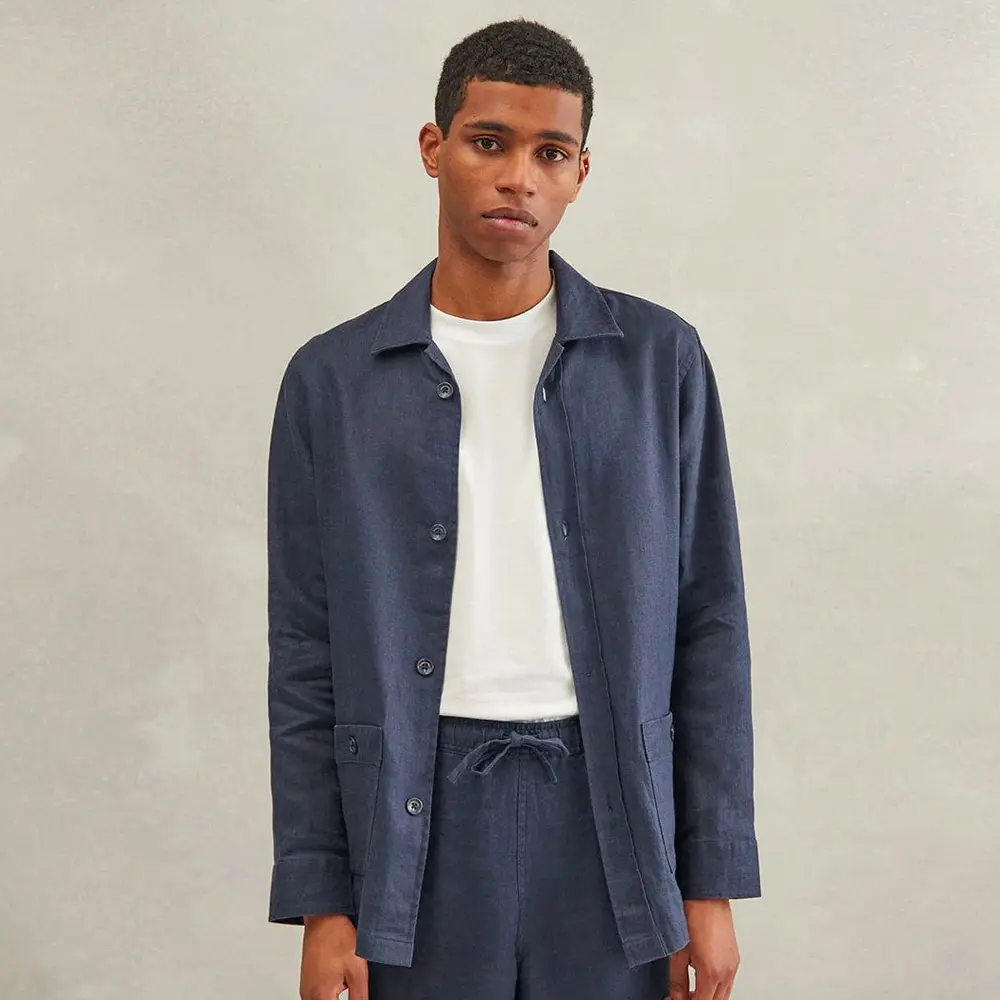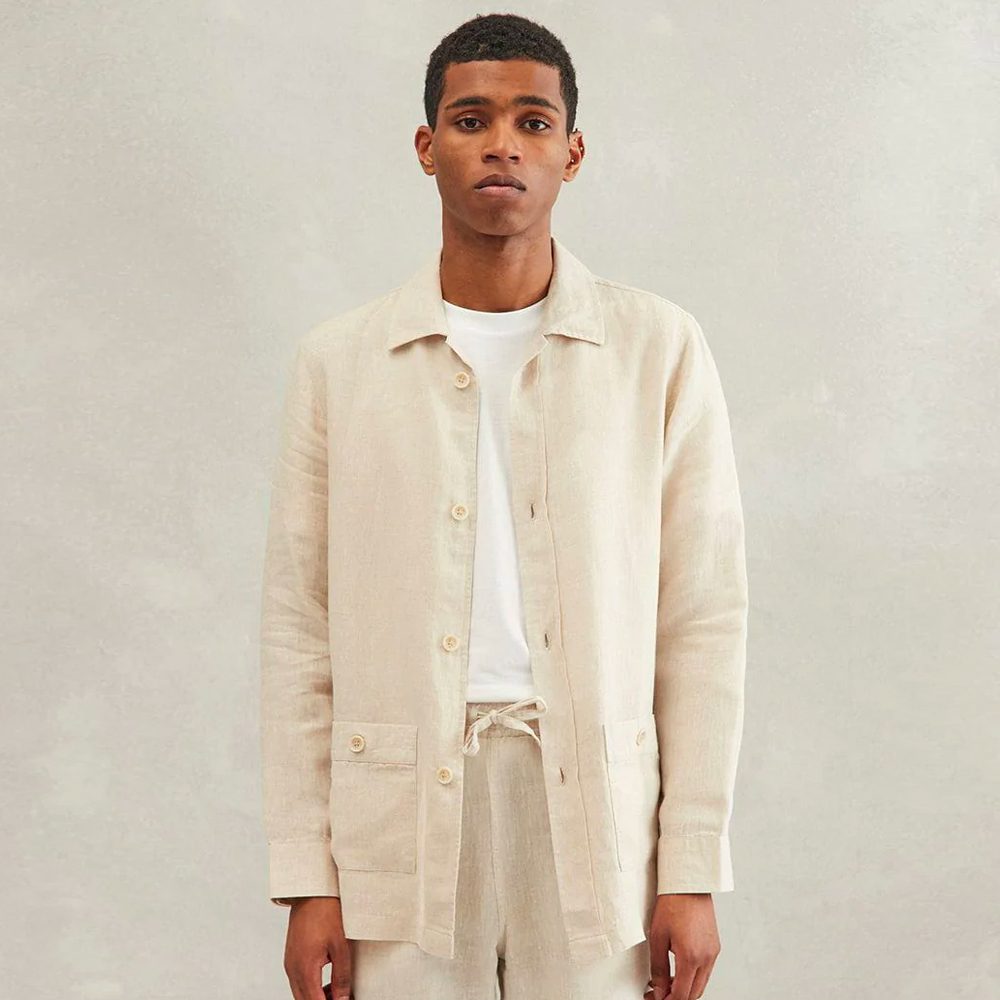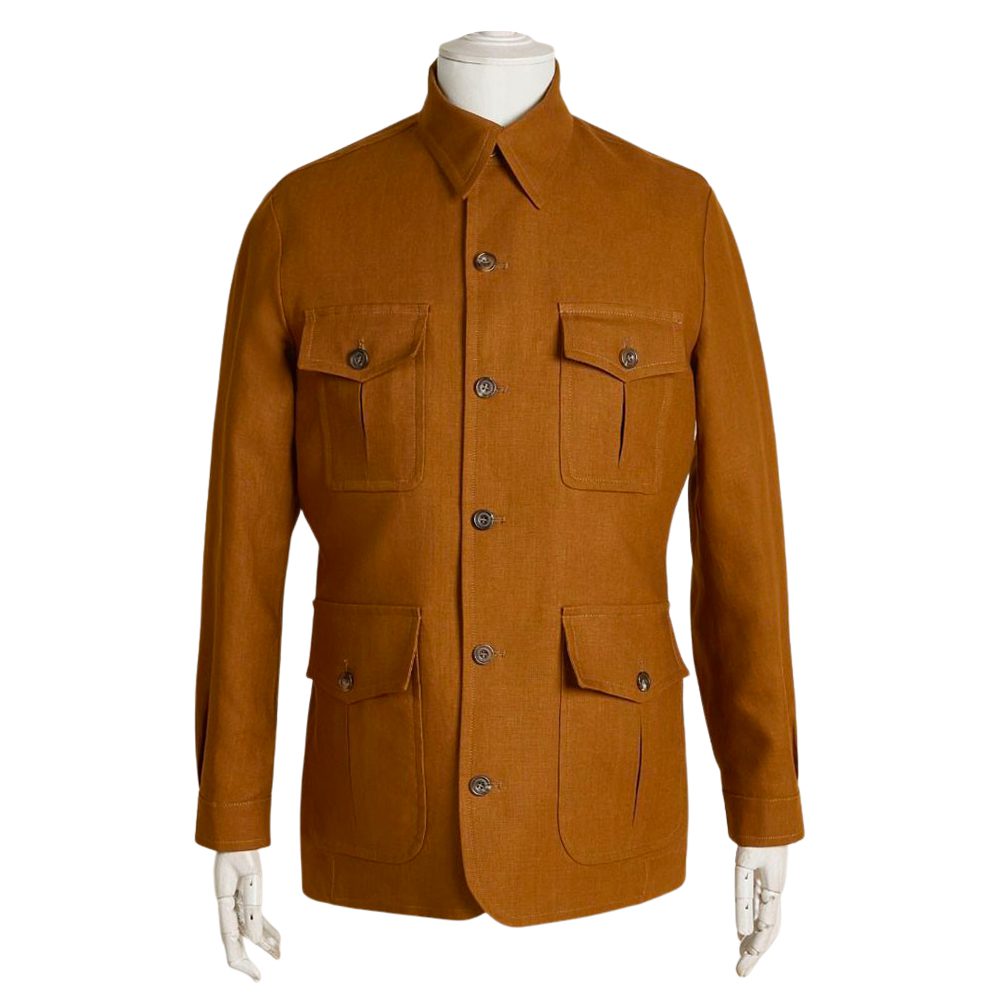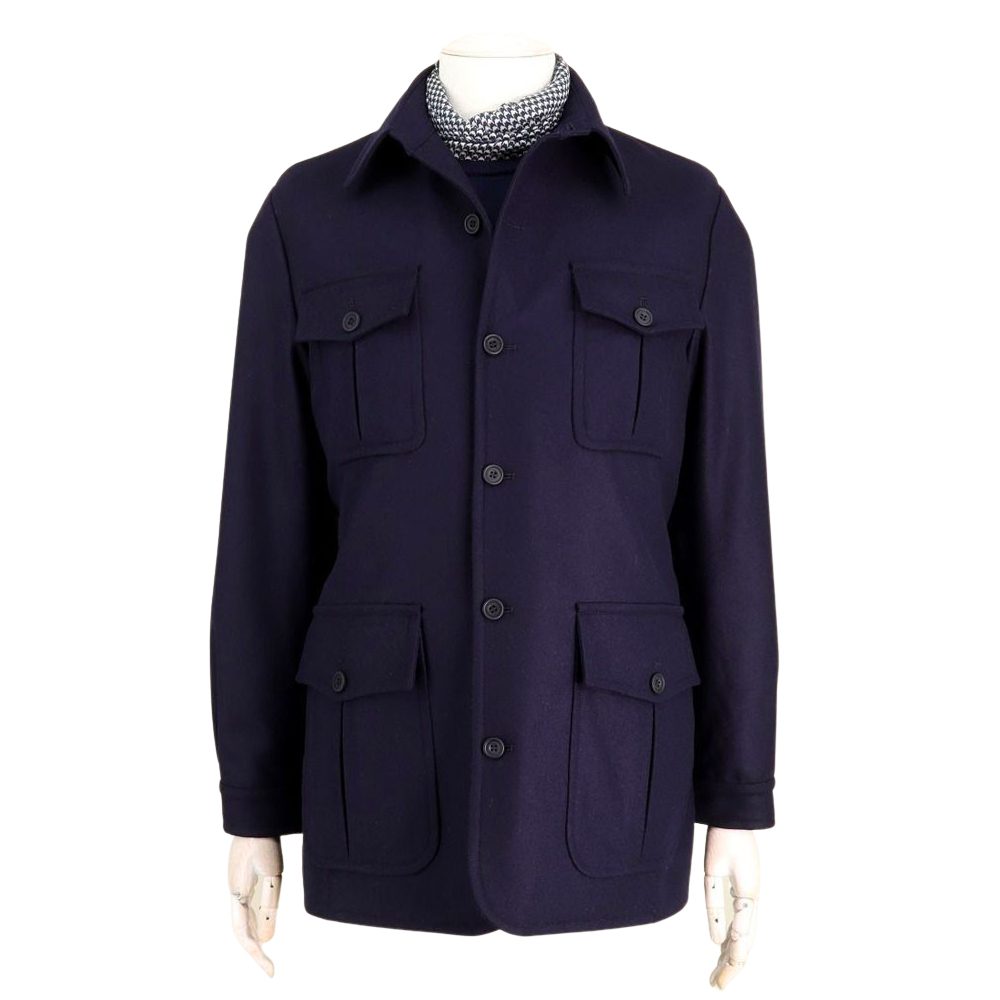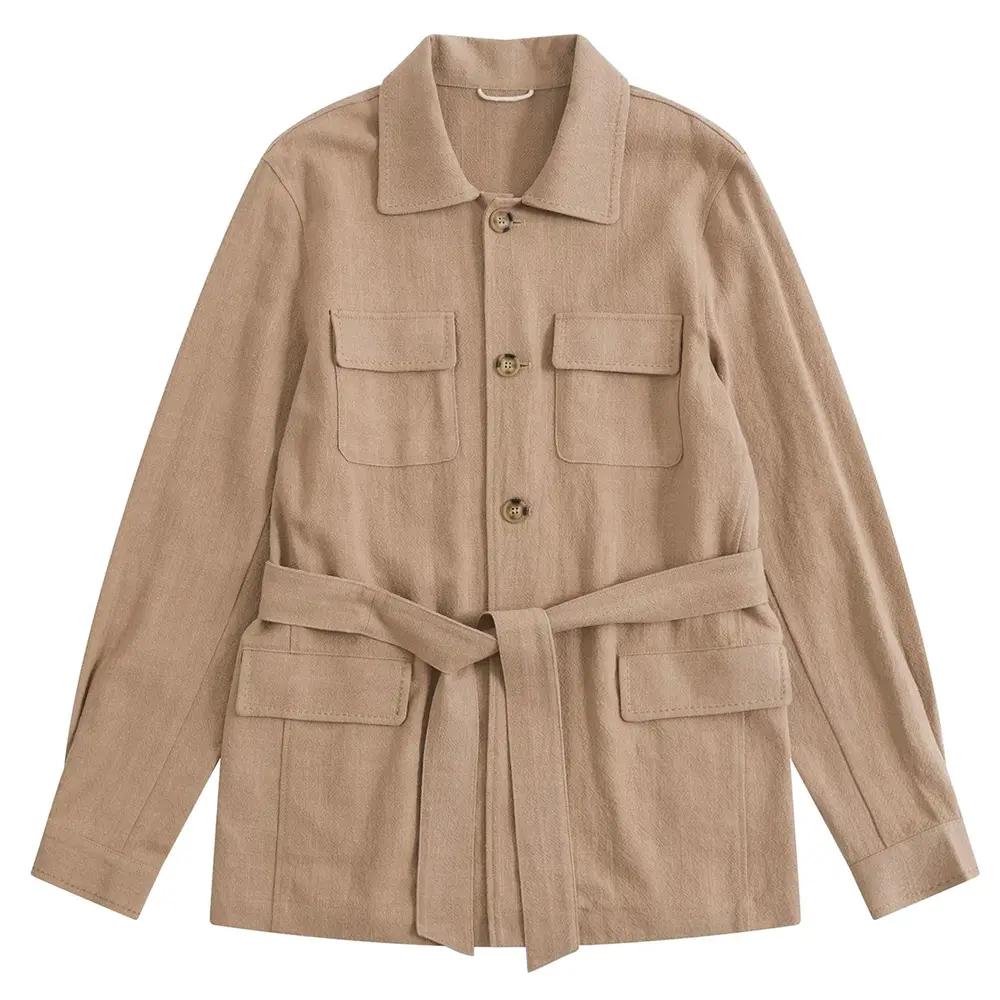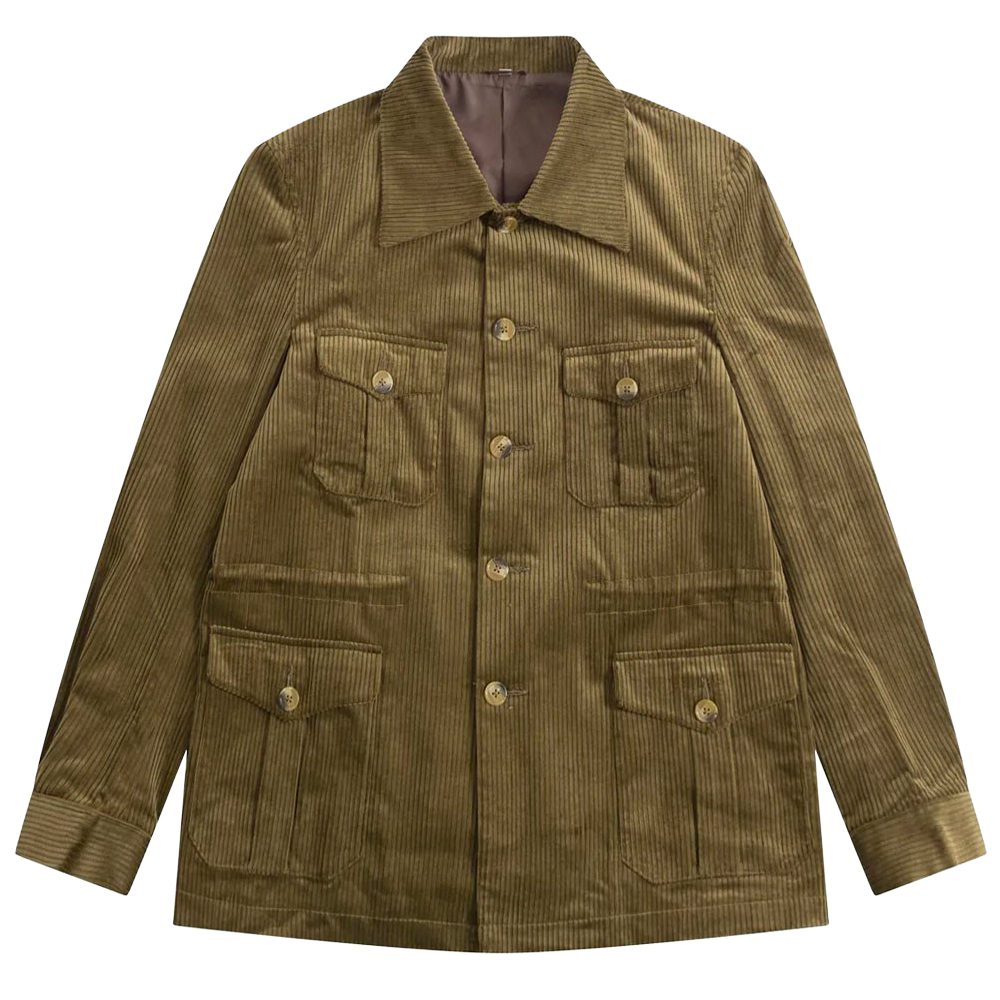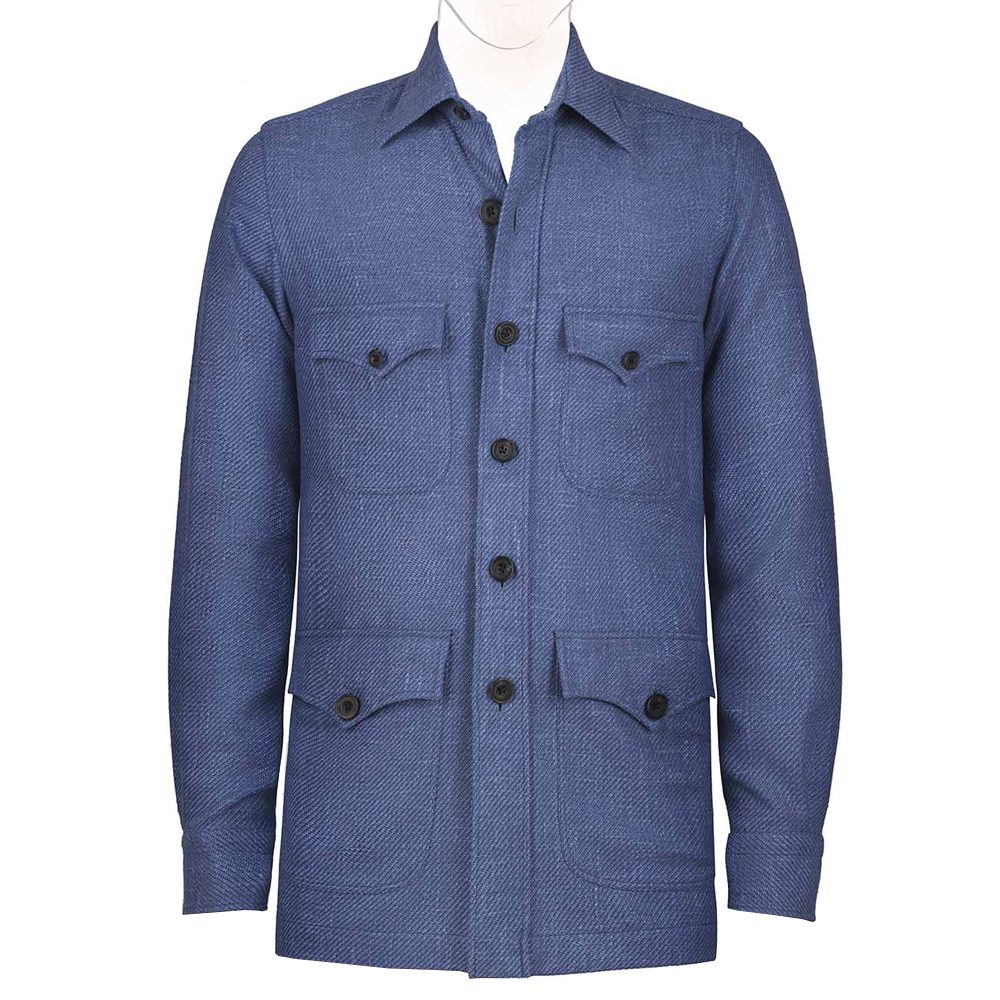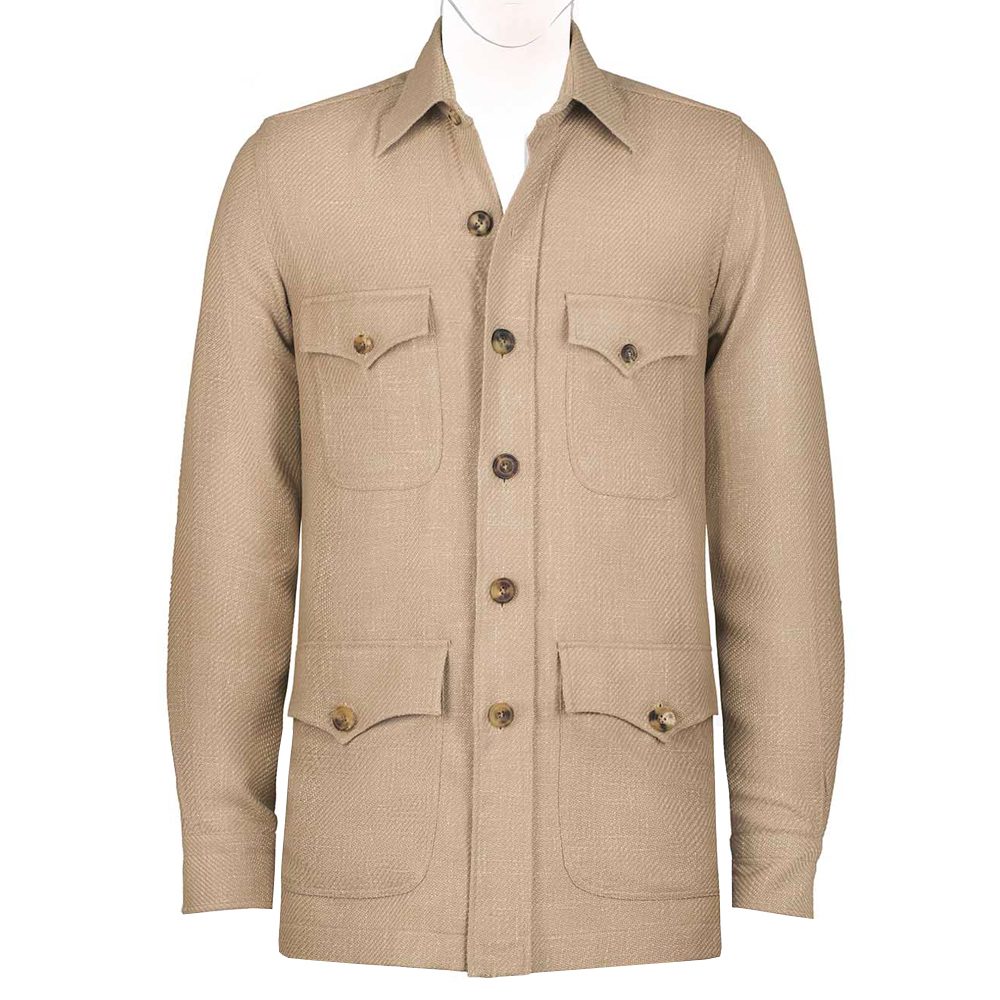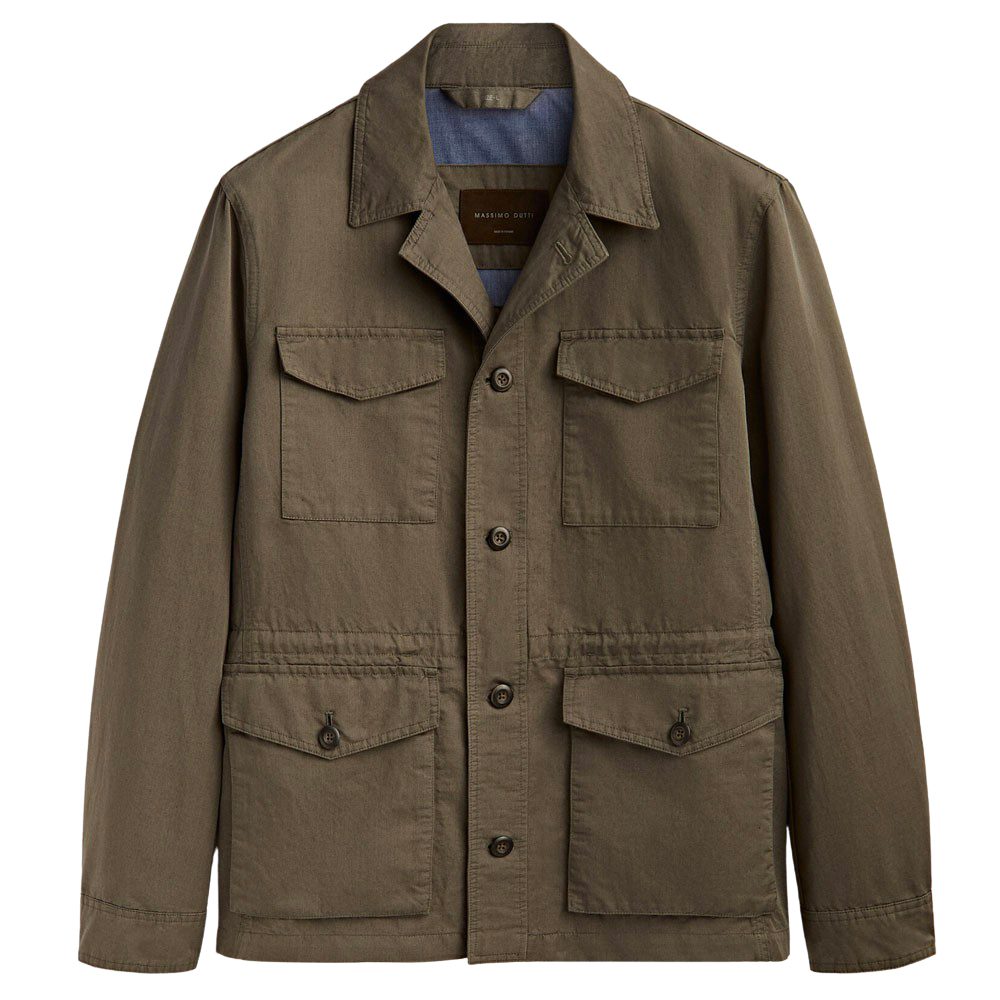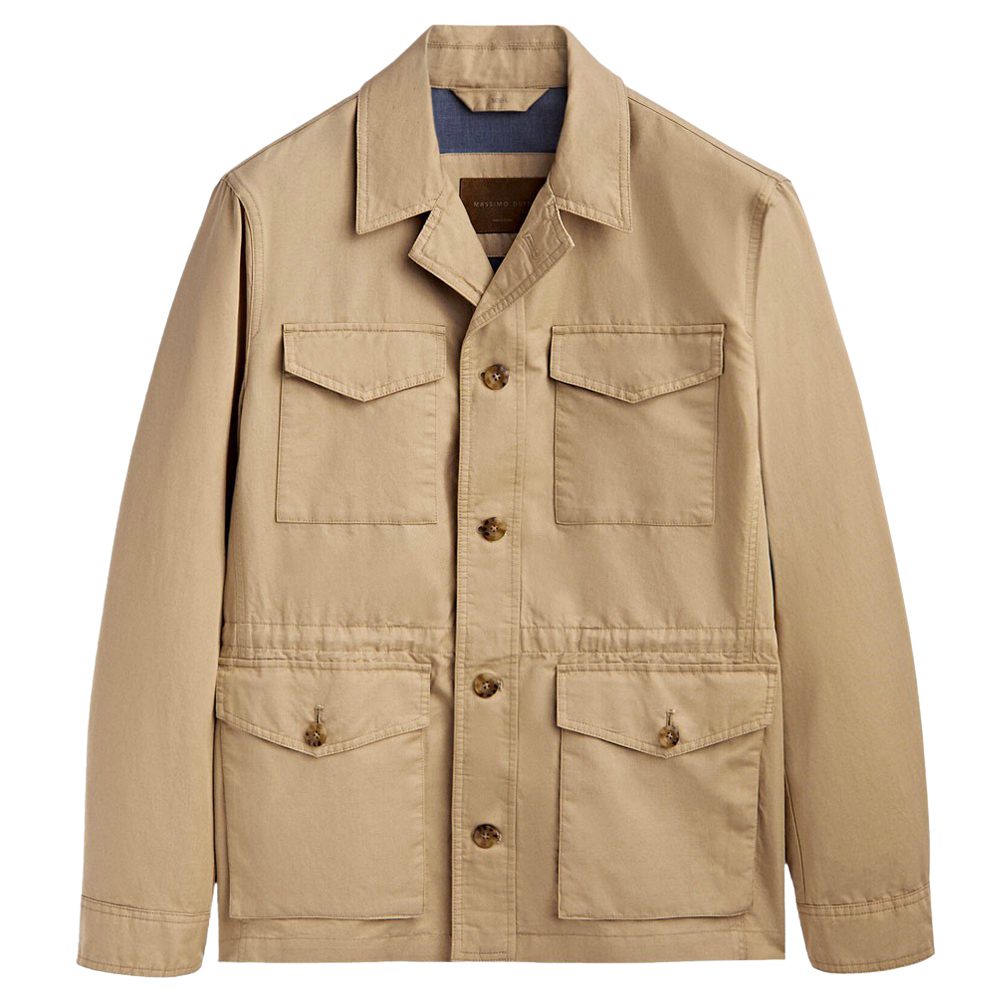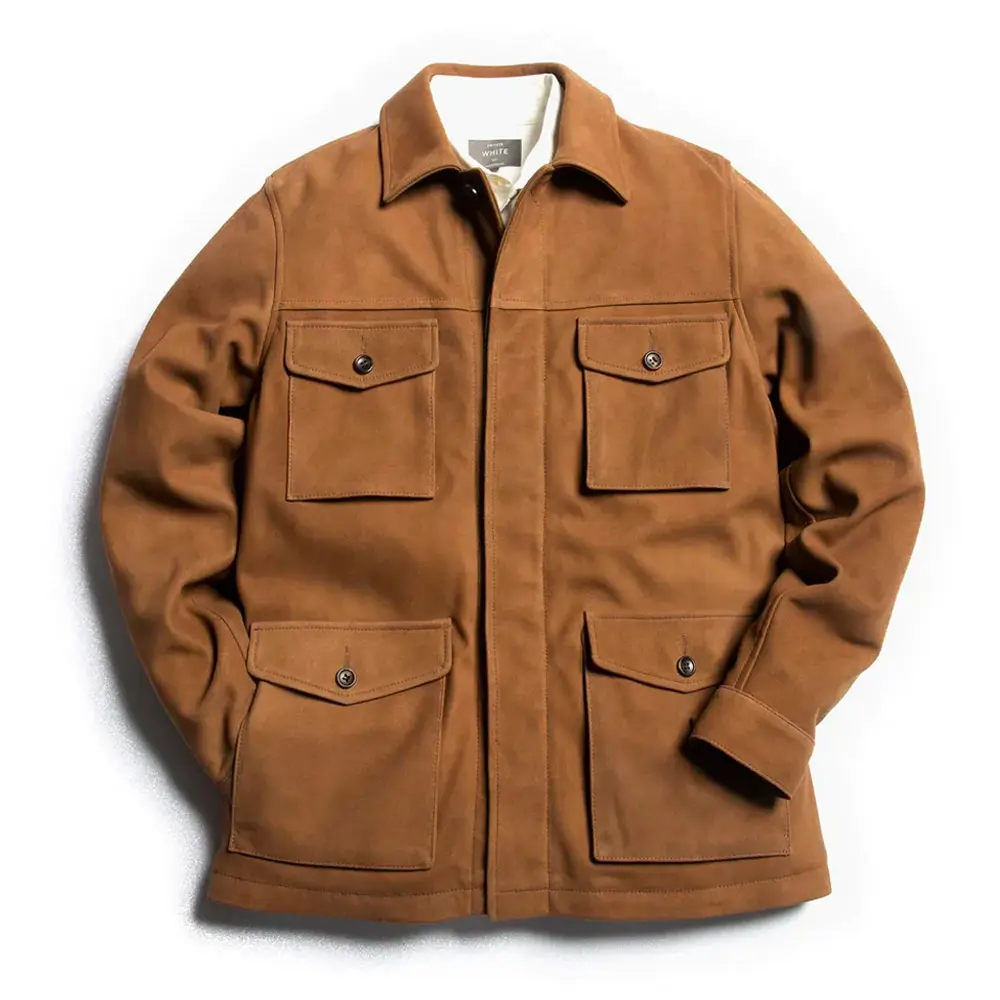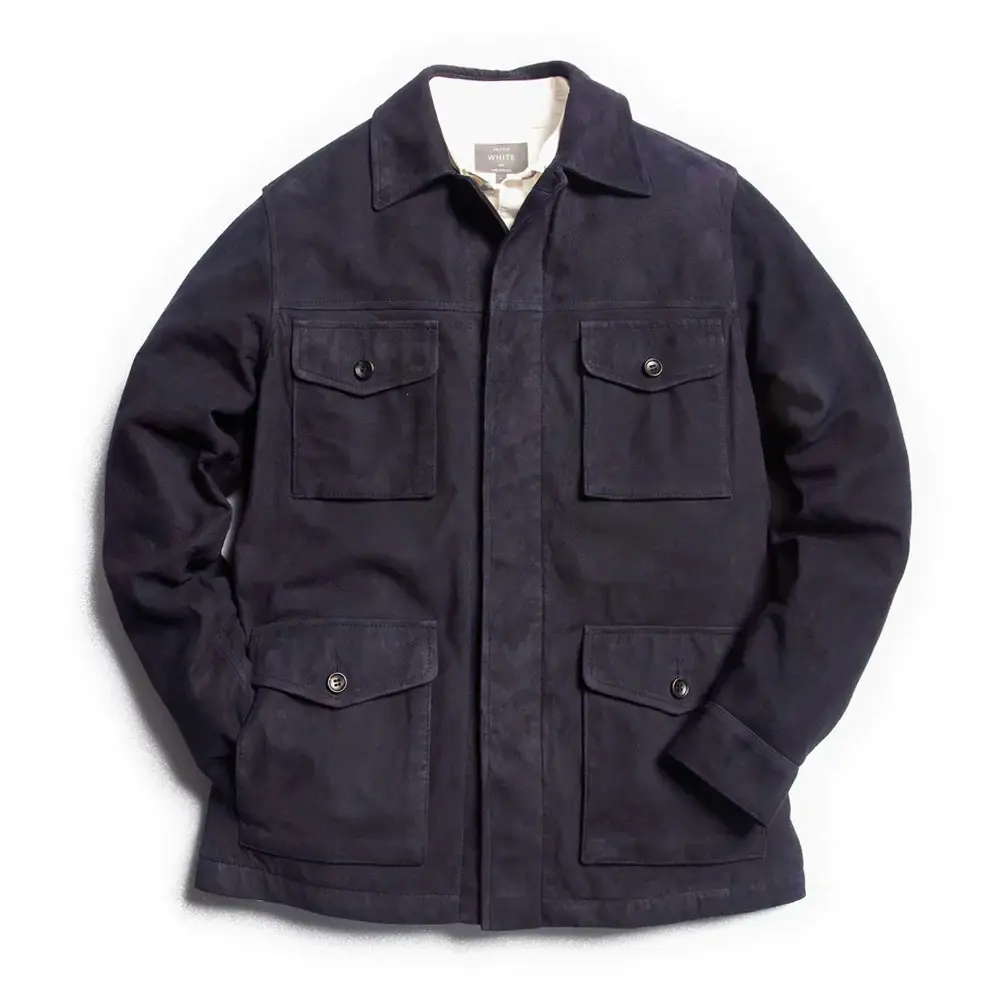The Modern Man’s Guide To The Safari Jacket
When most of us think of safari jackets, modern iterations are not the first styles that come to mind. Instead, we tend to drift back to cinematic examples from the 70s, when the likes of Roger Moore was never far from a belted four-pocket jacket as everyone’s favourite British spy, James Bond.
Iconic images of Ernest Hemingway in Africa wearing a safari jacket, or Clark Gable in Mogambo, have given the garment something of a retro, nostalgic aura and yet today’s contemporary styles are modern, elegant and sophisticated but sorely underrated. We’re here to tell you that the safari jacket is a fantastic bit of kit, and not just for the summer.
The modern safari jacket
While the general design of the modern safari jacket has not deviated too far from the original, the fabrications certainly have. Given that most of us won’t find ourselves crawling through the African bush stalking big game any time ever, the desire to wear rugged heavyweight cotton drill in an urban setting is somewhat diminished.
Therefore, lightweight cotton and linen styles are much more appropriate and common today, and in many cases the ‘jacket’ has morphed into something more closely resembling a four-pocket overshirt. The belted element comes and goes depending on the brand – luxury labels tend to keep it, whereas more contemporary brands drop it. Bellow pockets are also often swapped out for patch pockets in order to maintain a more minimalist tailored aesthetic better suited for the urban jungle, rather than the African one.
The safari jacket’s colour palette has broadened over the years, graduating from the khaki playbook to incorporate a wider variety of neutral tones, as well as black, navy, ivory and the occasional bolder hue.
Certain high-fashion houses have styled the safari jacket in a more modern sartorial direction since the belted style and pocket details help create sharp contours that complement tailored trousers. In contrast, brands that lean towards a casual aesthetic have incorporated the safari jacket more like a traditional workwear blouson to be worn with chinos, jeans or shorts in the summer.
Buying considerations
Materials
While the original versions were built to last, cut in heavyweight cotton drill, today’s versions are far more luxurious. Summer styles are typically crafted from lightweight cotton twill, cotton gabardine, linen fabrics, or a blend thereof.
Linen works really well thanks to its dry handle and slubby texture, which seems to complement the safari jacket’s inherent ruggedness. You can also find beautiful iterations in merino wool, cashmere and even shearling and leather for fall/winter but be prepared to cough up top dollar for these styles.
Modern technical fabrics such as nylon (and whatever else is marketed as ‘performance’ these days) are another evolution away from the original but can look really contemporary and are definitely worthy of your attention if you prefer an edgier or more athletic look.
Style
As previously mentioned, there are plenty of heritage brands – such as Turnbull & Asser and Anderson & Sheppard – who create safari jackets that adhere pretty well to the original silhouette, only in far more luxurious fabrics. The most important details, then, are the four front bellow pockets and the belted waist.
Contemporary iterations will often ditch the belt and streamline the pockets, or even do away with some of them so that the jacket resembles something between safari and chore/field jackets.
You’ll also find that lightweight cotton and linen styles wear more like an overshirt than a jacket, which is no bad thing and in fact probably a more versatile summer layer in any case.
Colour
Stick to the neutrals and you can’t go wrong. Beige, tan, olive drab… that whole khaki spectrum will serve you well and is a versatile colour group to style. Ivory and off-white tend to be slightly smarter and so are a good option if you want to combine the safari jacket with sharp tailored trousers.
Navy styles are a slick alternative too, and go well with smart city looks such as a navy suit or dark tailored separates.
How to wear a safari jacket
- Suitsupply
- Onsloe
Classic styles in cotton and linen can be dressed up or down, however you prefer. They work well with cotton chinos or jeans and a pair of chukka boots for a rugged off-duty look, while smarter belted safari jackets can be worn with slick cotton pleated trousers and loafers for a more polished look.
We’d recommend not wearing a stiff stand-collar shirt beneath the jacket as it’s one collar too many – instead opt for the soft-roll collar of a linen shirt, or choose a simple crew neck tee or fine-gauge knit.
Can you wear a safari jacket over a suit? Absolutely, especially if said suit is a relaxed neutral linen style, while a lightweight navy safari jacket will also be a good juxtaposition layered over a navy suit in the fall months.
Best Safari Jacket Brands
ISTO
- ISTO Ripstop Safari Jacket
- ISTO Ripstop Safari Jacket
Sustainable brand ISTO not only has the benefit of giving you a clear consumer conscience, but also does an amazing line of modern safari jackets cut from hardwearing cotton ripstop in ivory, military green and navy.
The classic four-pocket design remains, only ISTO have ditched the belt in favour of a concealed drawcord, which makes it that much more contemporary.
Percival
- Percival Safari Linen Jacket Navy
- Percival Safari Linen Jacket Natural
British casualwear brand Percival has taken a minimalist approach to its interpretation of the safari jacket, creating a lightweight overshirt in a beautifully soft linen cloth. Designed to be worn open, the two chest pockets have been ditched while the lower two have been converted into flat patch pockets.
Available in cream and navy, it’s a great addition to an elevated workwear wardrobe.
Anderson & Sheppard
- Anderson & Sheppard Linen Safari Jacket
- Anderson & Sheppard Loden Safari Jacket
British luxury heritage label Anderson & Sheppard has always created perennial safari jackets in the most sumptuous of fabrics. Adhering closely to the original specs, the Savile Row tailor has a very broad selection of safari jackets cut in cloths such as Irish linen, soft moleskin and Austrian loden, as well as a selection of lightweight Irish linen safari overshirts.
Craftsman Co
- Craftsman Co Beige Indian Textured Linen Rakish Belted Safari Jacket
- Craftsman Co Olive Green Corduroy Hemingway Safari Jacket
Based out in Hong Kong, Craftsman Co is a contemporary brand that likes doing things the old-school way. Its belted Indian textured linen safari jackets are simply some of the best we’ve seen. Also available in English corduroy, the jackets have all of the original detailing but are cut with a slim tailored silhouette for a svelte, sophisticated look.
Available in all the usual neutral tones as well as dusty pink and blue options.
Rubinacci
- Rubinacci Limited Edition Blue Wool And Silk Linen Safari Jacket
- Rubinacci Limited Edition Beige Wool And Silk Safari Jacket
The icon of Neapolitan tailoring also does a beautiful line of luxury safari jackets in predictably extravagant fabrics such as cashmere, silk blend and flannel.
Far more tailored than the original, as you would expect from Rubinacci, these jackets feature more of a lapel than a typical stand collar and hence can be worn in a classically sartorial way.
Massimo Dutti
- Massimo Dutti Cotton/Linen Jacket With Pockets Khaki
- Massimo Dutti Cotton/Linen Jacket With Pockets
Spanish brand Massimo Dutti never fails when it comes to elevating menswear classics for a modern audience and it wasn’t going to drop the ball with its safari jackets and overshirts.
The latter come in 100% linen for a really natural drape, while the safari jackets are cut in a cotton and linen blend, featuring four flap pockets in khaki and golden brown colourways, both of which look excellent with chinos and sneakers or loafers.
Private White V.C.
- Private White V.C. The Lord’s Jacket
- Private White V.C. The Lord’s Jacket
Manchester born and bred, Private White V.C. specialises in sustainable British manufacturing, focusing on those timeless menswear garments of which the safari jackets falls into.
It calls its unbelted version the Lord’s Jacket but it’s a safari by any other name, and is crafted from heavyweight goatskin suede with two chest pockets and two bellows pockets. Available in navy and donkey brown, while it’s too heavy for the summer months, it’s game on for spring and fall wear.
Shop now at Private White V.C.
The History Of The Safari Jacket
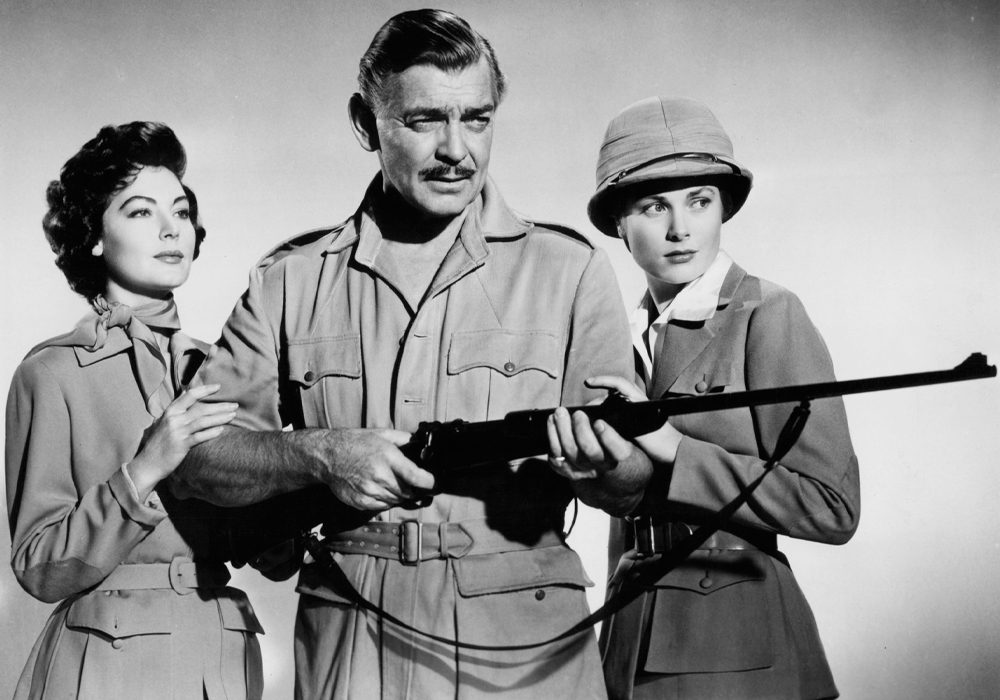
Clark Gable wearing a safari jacket in Mogambo (1953)
The genesis of the safari jacket is believed to have been a result of military necessity, as is often the case with a great deal of timeless menswear. British soldiers fighting in the Boer War in the late 19th Century quickly realised that their bright red tunics did little for their ability to blend into the South African background, unlike their aggressors who wore shades of beige and olive drab to disappear into the dry, dusty landscape. Hence the British soon came to love khaki, and the safari jacket was an off-shoot of this sartorial development, being cut from rugged cotton drill and having four front bellow pockets to carry around whatever a soldier needed to carry around in those days.
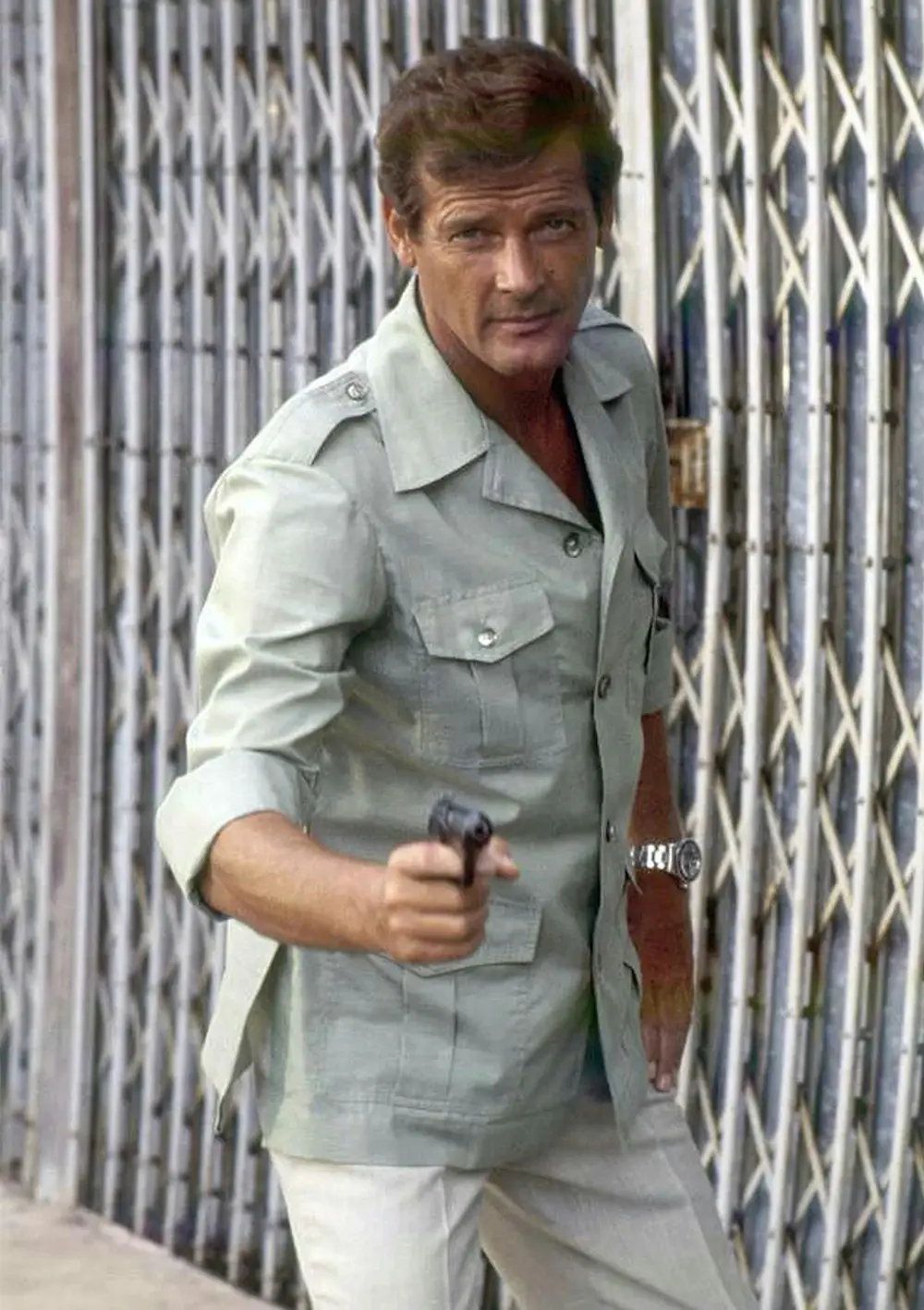
Roger Moore as James Bond in The Man with the Golden Gun (1974)
Naturally it was picked up on by hunters and outdoorsmen who by wearing it could remain largely inconspicuous to their prey while also being comfortable and very functional. It was rare that a safari jacket would be worn anywhere but the savannah (or Hollywood versions of it) up until around the late 1950 when popular culture started to stalk it – catalysed by its appearances in macho films such as The Road to Zanzibar (1941), Mogambo (1953), Safari (1956) and Hatari! (1962), then later by the aforementioned Mr Bond in The Man with the Golden Gun (1974) and Moonraker (1979).
It was Yves Saint Laurent who eventually took it mainstream in 1967, after creating a one-off version for a Vogue editorial.
